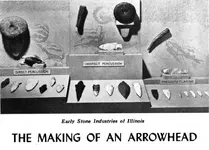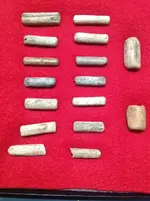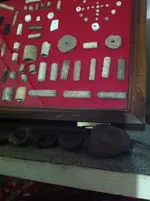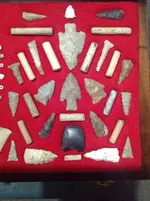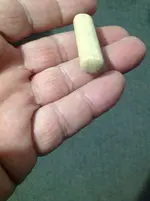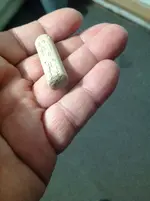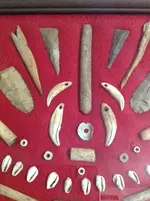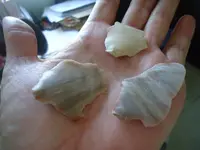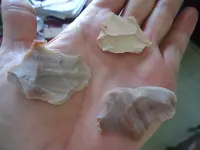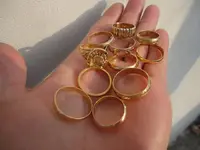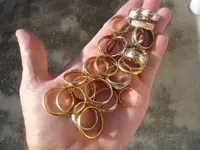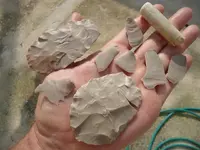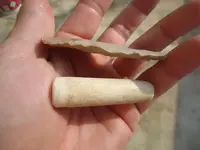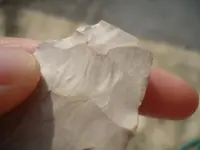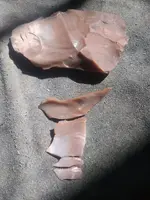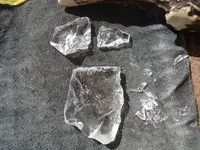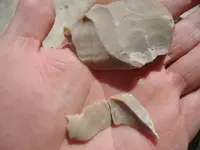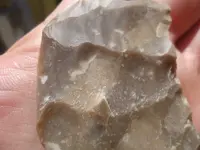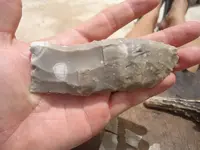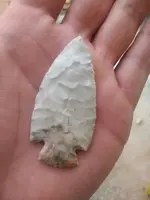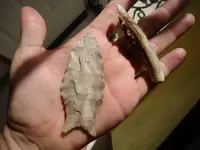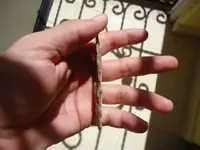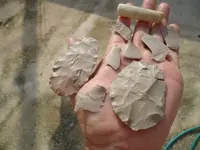Cool stuff!
do you have ave any more info pertaining to these tools?
Yes, regarding antler drift punches I have information from archaeological reports, and some opinions from flintknappers. I will share both, and you can let me know what you think.
This is from the first half of the 20th century:
1908 - "The exact use of the CYLINDERS OF ANTLER so often found, is not definitely known , but it is thought they may have been used as flaking tools, held between the stone blade and the hammerstone to be worked." - American Museum of Natural History, Clark Wissler
1910 - “SHORT CYLINDERS OF ANTLER, flat, battered, and splintered on one end, but convex on the other, perhaps flakers, and if so probably used with percussion on the end instead of with lateral pressure as the long cylinders were probably used, were found by Mills1 in the Baum site.” - Prehistoric Kentucky, Smith
1910 - "In some cases the flakes were removed by setting a PUNCH-LIKE INSTRUMENT upon the proper point, and striking it with a mallet..." (Handbook of American Indians North of Mexico, Volumes 3-4, Frederick Webb Hodge)
1916 - "A fragment of a cylinder made from a deer's horn was found. This is no doubt a piece of one of the common tools used by all the Eastern tribes for flaking arrowheads from suitable stone..." (Contributions from the Museum of the American Indian, Heye Foundation: Volúmenes 4-6)
1917 - "The second person then would strike the flaker with a stone hammer. The angle at which the flaker is held against the flint determines the length of the chip. The second kind of flaking tool, shown in Fig. 80 was perhaps used in the manufacture Ohio archaeological and historical quarterly - Volume 26 - Page 429
1917 - "Such hammerstones were applied directly to the material in removing large; flakes, but punch like cylinders of antler (Fig. 23c) were probably sometimes interposed between the hammerstone and the edge of the blade to be flaked..." - American Museum of Natural History
1918 - "The only object of antler found with the burials is a flaking tool which accompanied skeleton 44. It is a SHORT, COMPACT, CYLINDRICAL piece of ANTLER (2-3/8 in. long, 1/2 inch in diameter), and shows the effect of considerable use. It is of the type of implements used in connection with a hammer for removing the large flakes during the initial stage of chipping which followed the general roughing out of a prospective stone tool." (Museum of the American Indian, Heye Foundation, Contributions, Vol 2-3)
1919 - "Occasionally a needle with a central perforation is encountered, but CYLINDERS OF ANTLER, used for chipping stone points, are common." - (The pre-Iroquoian Algonkian Indians of central and western New York:, Alanson Skinner)
1919 - ""But if a large spearpoint or knife-blade is ultimately desired, an intermediate tool is needed. This is apparently (Ishi never made one for me to see) a short, stout, blunt-pointed piece of bone or wood serving as a sort of punch and sometimes as a lever. As a matter of fact, what is wanted in the case of producing a large implement is not the division of the obsidian mass but the trimming down of this mass by the detachment from it of all unnecessary portions." (Handbook of aboriginal American antiquities, W.H. Holmes
1920 - "In a number of specimens, one end is battered or split from repeated blows of the hammer. Unlike the ordinary antler flakers used in finishing blades by pressure, the ends of these punches are nearly always symmetrically rounded" (Indian village site and cemetery near Madisonville, Ohio, Earnest Albert Hooton)
1920 - "On plate 6, ag, are shown several flint- working punches of antler. A considerable number of these were obtained, the majority being about one and a half inches long and three-eighths of an inch in diameter. A few, however, were larger. These were used undoubtedly with a hammer of stone or hard wood, in flaking suitable pieces of flint from large masses, and for the roughing out of blades and projectile points. In a number of specimens, one end is battered or split from repeated blows of the hammer. Unlike the ordinary antler flakers used in finishing blades by pressure, the ends of these punches are nearly always symmetrically rounded." (Papers of the Peabody Museum of Archaeology and Ethnology, Harvard University, Volúmenes 8-9)
1920 – “But one other variety of antler implement was obtained, a sort of ELONGATED CYLINDER, probably a flint flaker, unearthed from pit 67. In this pit at a depth of 22 inches lay a folded skeleton heading west and facing south. The spine showed distinct indications of disease, and certain other bones seemed abnormal. Between the head and knees lay a deposit of objects among which figured the ANTLER CYLINDER, stained green and well preserved by copper salts from a sheet of that metal just above it. Here were also an oval flat stone showing wear, an iron trade knife, and a small flint point, while near the neck of the skeleton a few trade beads came to light. A few other similar bone or ANTLER CYLINDERS in poor condition were discovered with the skeleton in pit 68, before described. It will be noticed that the skeletons of both pits 67 and 68 had what might be called arrow-making outfits," (UNIVERSITY OF NEW YORK)New York State Museum of Natural History, Bulletin: Números 235-240
1920 - "Unlike the ordinary antler flakers used in finishing blades by pressure, the ends of these punches are nearly always symmetrically rounded. A piece of antler from which punches have been cut is shown in h. The antler was worked into a rod several inches long, with an un- worked portion at one end for a handle. The rod was then cut into sections. Many of these refuse pieces were found in the debris. In the accounts of the process of flint chipping by the Indians there are few references to the punch and hammer. It is apparent, however, that their use was wide-spread as a preliminary process to the final pressure flaking by the ordinary antler tools with special working ends. In the collections of the Museum there are examples of these punches from the village sites in other sections of Ohio, from the Iroquoian sites in New York, one good specimen from a Maine shell-heap, and a number from various places in..."
1921 - "Consider for a moment the actual technique of flint-chipping, as it can be studied among people who still use flint tools, such as certain tribes of North American Indians. The simplest way is to hold the flint nodule in the left hand and to strike it with a stone which does duty as a hammer, held in the right. A large flake is thus dislodged. If a smaller flake is to be removed, pressure, rather than a blow, is applied, the fabricating tool being applied pressed laterally against the edge of the flint. A yet more delicate chipping is produced with indirect percussion, in which the mallet strikes, not on the flint, but on a punch — a bar of stone, or when such can be procured, a nail — held against the flint operated upon. Sometimes this work will require two operators, one holding the flint and the punch, the other the mallet; but sometimes an expert man can work alone, holding the flint in his palm and grasping the punch between his first two fingers." ( A text-book of European archaeology: Volumen 1 ,Robert Alexander Stewart Macalister)
1921 - "The relatively large number of the short antler punches found in comparison with the long pressure flakers (the ratio being roughly about one hundred to one) would seem to indicate that the smaller punches may have been used in the final flaking of at least a considerable portion of the coarser chipped implements." ( Papers of the Peabody Museum of American Archaeology and ...: Volumen 8)
1921 – “Antler Objects Chipping Tools. — An antler prong worked into a RUDE CYLINDER, the end of which shows wear, ... These CYLINDRICAL ANTLER TOOLS are apparently commoner west of the Cayuga country, on Seneca and Neutral sites.” - Notes on Iroquois archeology, Alason Skinner
1921 - "Besides these there are many CYLINDRICAL ANTLER PUNCHES used in flaking arrow points." (The founders of the New York Iroquois league and its probable date, William Martin Beauchamp)
1922 - "Antler was extensively fabricated for various purposes...NUMEROUS ARROWMAKERS PUNCHES recall the abundant chert points. One arrow point made of antler in the usual triangular shape was found."
"Somewhat unique are the arrow points made from antler tips. Of these several were found in various stages of manufacture. This type of point is infrequent on Seneca sites. Besides these there are MANY CYLINDRICAL ANTLER PUNCHES used in flaking arrow points. Plate V1IA shows some of these."
"The articles found in the graves are identical with those from the villages of Ganounata and Totiakton already described, but a few burials showed distinctive features. Prom one grave the writer took a COMPLETE CHERT CHIPPING OUTFIT, comprising RAW CHERT, partly worked points, a finished point, a small, flat, stone anvil, and TWO ANTLER PUNCHES."
1928 – “CHIPPING TOOLS - Six, short, BLUNT SECTIONS OF ANTLER, with rounded or conoid ends , found here, were possibly used as CHIPPING PUNCHES for arrows and other artifacts. Plate XIX, figures 1 to 4, shows the different kinds and sizes.” - (Uren prehistoric village site, Oxford county, Ontario,)
1929 - "Pins of Antler... The pin shaped peice of antler found in heap A (Plate XVI, figure 6) was brought to nearly a CYLINDRICAL FORM, with one end nearly flat and the CELLS THERE COMPRESSED from being POUNDED. Slivers were broken off at the edge. The other end is slightly smaller and so bluntly pointed as to be nearly dome shaped. It to shows LONGITUDINAL COMPRESSION OF THE CELLS, as if from being held against something while the other end was POUNDED.." (Some shell-heaps in Nova Scotia, Harlan Ingersoll Smith)
1930 - "From deer antler they fashion small cylindrical implements for chipping flint, and from the hollow wing bones of the eagle, the owl, and other birds they cut tubular sections to be worn as beads." (The Moundbuilders, H. C. Shetrone)
1931 - "ANTLER CYLINDERS for chipping flints were common..." - The Western Pennsylvania historical magazine: Volumen 14
1935 - "In the various accounts of flint chipping by the Indians there are few references to the punch and hammer. It is apparent, however, that their use was wide-spread as a preliminary process to the final pressure flaking of the more delicately finished blades." ( Antiquities of the New England Indians: with notes on the ancient cultures of the adjacent territory, Charles Clark Willoughby)
1935 - "excellent bone and antler work, including incised bone and antler bracelets, awls, picks, scapula digging tools, small bone fishhooks, bone beads, CYLINDRICAL ANTLER TAPPING TOOLS or PUNCHES, perforated antler shaft" (An introduction to Nebraska archeology: (with 25 plates)
1936 – “No CYLINDRICAL ANTLER CHIPPING TOOLS used in flaking or chipping stone arrow-points or scrapers were found, although they are common in Iroquoian sites elsewhere in Ontario and in New York. If such tools were used as CHIPPING TOOLS, as is generally believed, their absence here would correspond with the scarcity of chipped objects.” - Roebuck prehistoric village site, Grenville county, Ontario, William John Wintemberg
1937 - "The cylindrical flint-chipping tools have the following dimensions : at South Park, 2.5cm. to 6.2cm. in length, with an average diameter of 1cm. ; at Turtle Hill, 3.1cm. to 4.9cm. in length, with the same average diameter." (Ohio History: Vol. 46-47)
1938 - "Conspicuously absent from the Renner site was the otherwise highly typical Plains digging tool or hoe made from the scapula of the bison, though the type occurs commonly in nearby sites of different cultural affinities and probably of later date. Socketed conical projectile points with characteristic single basal tangs (pi. 4, Z>), curved "cylinders" or tapping tools (pi. 4, F), flakers (pi. 4, O), and strainers (?) (pi. 4, E) were made of deer horn, while from various caches were taken several more or less complete sets of antlers." (HOPEWELLIAN REMAINS NEAR KANSAS CITY, MISSOURI, By Waldo R. Wedel)
1938 - "Antler played a minor role in the choice of raw material, serving in only two " pitching tools" or punches, figs. 10, 11." (Certain recently explored New York mounds and their probable, William Augustus Ritchie)
1939 - "With this burial there were also an ANTLER DRIFT ground flat at both ends, two flint drills 112 mm. long, used as reamers, and a polished stone, 114 x 44 x 25 mm." - (The Chiggerville site: Site 1, Ohio county, Kentucky - William Snyder Webb, William George Haag)
1941 - "Every Indian I have seen making arrowheads—and there are still some who know the art—employ the same methods...So the Indian had to rough it into shape by percussion with his hammerstone or with a deer antler mallet, knocking off large chips. Or, he tied his bone flaker to a stout long handle that would give him more leverage and power to press off longer and larger flakes. Another method was a combination of percussion and pressure, for which the services of a helper were needed. He held the flint against a block of wood while the workman set an antler cylinder or "pitching-tool" against the edge at the point where he wished to remove the flake, and struck the tool sharply with his hammerstone. Of course, as in all flint-work, the tool must touch the flint at just the proper angle, which can only be determined by experience. " - (Desert Magazine, There's No Mystery About Arrowheads, Archaeologist M. R. Harrington)
1941 - "Widespread common artifacts are socketed projectile points of either bone or antler; several varieties of ... mussel shell spoons; ANTLER DRIFTS WHICH MAY BE TAPPING TOOLS; small flat grinding stones; numerous fire-cracked stones" - ( American Anthropological Association, Anthropological Society of Washington (Washington, D.C.), American Ethnological Society)
1942 - "Burial No. 92.—This type-2a burial was only 1.4 feet below the surface in square 85L15. With this burial, shown in plate 83, figure 2, were 43 objects listed as field specimens. Among them were six flint points, six flint knives, three bone awls, a slate whetstone, an antler spear point, and a SERIES OF ANTLER DRIFTS IN VARIOUS SIZES. Two of these were drilled horizontally in such a way as to suggest they were used as shaft straighteners. This collection of tools might at once suggest that this man in life had been specially skilled in the working of flint. Some of these flint points with this burial were especially well made, and are shown in plate 92, figure 2. These associations, made of bone and antler, are shown in plate 97."
"Plate 97 presents 30 specimens of worked bone and antler. The bone awls and antler spear points are of the usual form, but the number of HORN DRIFTS excites interest. They vary greatly in size, many showing battering as if they had been much used. Two cut antlers are so fashioned that they could have been used as very effective hammers in percussion fracture of flint.In plate 97, figure 1, a section of horn has a round hole a half inch in diameter drilled through it. This was probably an arrow shaft straightener, serving as a wrench in holding and bending the shaft in the process of manufacture. In plate 97, figure 2, are shown two larger antler sections which have been drilled. These holes are elliptical and show that the interior surface and edges of these holes have been smoothened by wear."
"Burial No. 89.—This burial was of type la at a depth of 1.9 feet below stake 40R4. With it were TWO ANTLER DRIFTS and a netting needle made from a bird bone."
"Burial No. 7-5.—This burial of type 5a was 6 feet below stake 90113. It is shown in plate 138. It was unusual because of the large number of burial inclusions. Some 33 field specimens were listed. These included 4 HORN DRIFTS, 8 bone awls, 16 animal jaws, 3 flint projectile points, 1 shell gorget, and a cache of seed pods fairly well preserved. A number of these specimens are shown in plate 147."
"Antler was cut into sections from 2 to 5 inches long and ground to blunt ends. These are classed as antler "drifts"; typical forms are shown in plate 147.
"Burial No. 126.—This was a type-lb burial at a depth of 4.3 feet in square 80L9. It is shown in plate 88, figure 2. With it were ANTLER DRIFTS, a flint point, and shell beads."
"In plate 221, figure 2, is shown a series of antler tools—BLUNT DRIFTS, which might have been used in the INDIRECT PERCUSSION fracture of flint; also ANTLER CHISELS, and sections of antler, which were drilled"
"Bone specimens from the general digging are shown in plate 256, figure 1. The awls were from the leg bones of turkey and the loon. The four bone pins and nine bone needles were quite typical of this site. The longest is 6 inches in length and the smallest is 3.5 inches in length. The HORN DRIFTS vary in length from 1,8 inches to 3 inches long. There are presented in the figure four true bone projectile points."
"Burial 88.—This was a partially flexed bmial at a depth of 11.2 feet below stake 70L16. With it were 10 projectile points—1 flint spear, a bone flaker, an ANTLER CHISEL, a BONE DRIFT, and an incisor of a large rodent, all shown in plate 291, figm-e 2. The positions of the artifacts in situ are shown in plate 302, figure 1. Two dog burials were at the same level nearby, as shown in plate 300, figure 1."
"In table 34 is shown the distribution of antler spear points, antler drifts, and other worked-antler objects, as well as the occurrence of other traits in the upper levels of this mound. It is interesting to note that the use of worked-antler spear points drifts—and other antler objects began just after the 9-foot level was laid down. It is to be remembered that one of the important products produced by the flint workshop at the 9-foot level was a flint blade well adapted to the cutting of horn. Before these knives were produced there seems to have been no cut antler at this site. Antler objects continued upward from the 9-foot level, through the pottery zone, to the mound surface. In this region worked-shell specimens near fire-burned clay hearths. The occurrence of such burials and hearths is shown in table 34 to be in the same general region as the antler artifacts, definitely concentrated in the levels above the shop-site level, in a region of abundant flint. Types of antler drifts are shown in plate 286, figure 2. It is not surprising they should be associated in levels containing much flint. Flint knives may have been used in cutting them, but it is also probable that they served as tools in flaking flint by INDIRECT PERCUSSION fracture."
1942 - "Antler Object. A small cylindrical piece of cut antler with the ends rounded, probably used in chipping flint ; length 3.2 cm, diameter .9 cm." - (Transactions, American Philosophical Society - Abercrombie Site)
1942 - "In the better specimens the shaping of blades was accomplished by a process which took off wide, flat flakes; we should suspect indirect percussion with punches." (Southwestern lore: Volumes 8-10 , Clarence Thomas Hearst)
1943 - "a punch or chisel into the flint." Evidently indirect rest percussion was employed. The piece of flint was no doubt held upright between the feet of the worker; and the implement was probably finished by a pressure process, such as the Lacandons still use" (The Indian background of colonial Yucatan, Ralph Loveland Roys)
1943 – “Many CYLINDRICAL or FLATTENED-CYLINDRICAL CHIPPING TOOLS, both long and short, were found (PI. XLIV, Fig. 8),” - The Fort Ancient aspect: its cultural and chronological position , James Bennett Griffin
1943 – “A second important group comprised the CHIPPERS or DRIFTS, TWO-INCH LONG, CYLINDRICAL PIECES of HARD ANTLER, sometimes rubbed to a fine polish, but with occasional rougher examples represented (PI. IV, Fig. 2)." - PRO PATRIA OFFICERS FOR Michigan
1943 - "FLINT-CHIPPING TOOLS : Sixty-eight flint-chipping tools of the CYLINDRICAL TYPE (Fig. 11, Nos. 2-5) were found, of which thirty-three are complete specimens. They were cut from sections of deer antler and are rounded bluntly at each end. Their average length is 39 mm. and average diameter 10 mm." (Ohio history, Volume 52)
1945 - "In the better specimens the shaping of blades was accomplished by a process which took off wide, flat flakes; we should suspect INDIRECT PERCUSSION WITH PUNCHES." (Southwestern lore: Volúmenes 6-10 )
1945 – “CUT ANTLER SECTIONS. This trait is fairly frequent in Adena villages. SECTIONS OF ANTLER some three inches long seem to have been used as drifts. The rounded ends show battering as if they were interposed in percussion between the hammer and the object struck.
1945 – “Bone and Antler Implements 6 small, CYLINDRICAL, ANTLER CHIPPING TOOLS, all in some degree defective (Fig. 4, d, e).” (An archaeological survey of the Trent Waterway in Ontario, Canada Alfred Kidder Guthe, Joseph Ralph Mayer, William Augustus Ritchie)
1946 - "The tips of these tines were often quite blunt, suggesting their possible use as flaking tools, or possible PUNCHES. ... Cut distal portions of tines may be, in some instances, at least, a by-product of the making of ANTLER DRIFTS" - Alabama Museum of Natural History
1946 - "Dorset tools for working chert include the bone pressure flaker and the bone or ANTLER CYLINDRICAL PIECE used for INDIRECT PERCUSSION." (Man in northeastern North America, Frederick Johnson)
1946 – “Antler drifts, made from sections of antler, are ground or worn on the ends and may show evidence of considerable grinding or abrasion through use over their entire surface. Seventy-six of the DRIFTS were complete enough to permit measurements of length. Lengths range from 1-1/4 to 4-3/4 inches…”
1946 – “SECTIONS OF ANTLER with squared ends; considerable battering and smoothing at ends indicates use as DRIFTS, TAPPING TOOLS, or similar uses.” The University of Texas publication: Issue 4640
1946 - "The channel flakes were then knocked out, probably by INDIRECT PERCUSSION, and the point was given its final form by secondary pressure flaking around the base , sides, and the tip." - (Colorado magazine: Volúmenes 22-24)
1946 - "which may be analogous to the Plains "TAPPING TOOLS" or "CYLINDRICAL ANTLER TOOLS," for he found only 17 specimens scattered through all periods of Pecos rubbish. The three shaft wrenches of bison rib at Pecos also seem to have been"
1946 - "Because antler could be easily worked, but was strong and tough, sections of it were used as "DRIFTS" in indirect percussion fracture. It was well adapted to such use." (Indian Knoll, site Oh 2, Ohio County, Kentucky, William Snyder Webb)
1946 - "Why have the Eskimo given so much to the Indians and received so little? The only types which I am sure that they took from the Indians were the snowshoe needle (if my interpretation of Dorset and New York Archaic specimens is correct) 117 the CYLINDRICAL TOOL for INDIRECT PERCUSSION, one axe grooved across the top, and a few plummets" (Man in northeastern North America, Frederick Johnson)
1947 - "three long, narrow objects cut from the thicker edge of bison ribs and having blunt, rounded tips; and TWO CYLINDRICAL ANTLER "TAPPING TOOLS" (pl. 7 b) . Weapons; (A) Arrow (?) Points. Because of their thinness, lightness," (Culture complexes and chronology in northern Texas: with extension)
1947 - "Chipping Implements: flaking tools of bone and antler, WITH BLUNT ROUNDED ENDS ("ANTLER SECTIONS TAPPING TOOLS", "DRIFTS", possibly used in flaking." (Culture complexes and chronology in northern Texas, Alex Dony Krieger)
1948 - "Other traits of Archaic 3 include ANTLER DRIFTS, spear points, atlatl hooks, and head dress; stone gorgets, atlatl weights, and beads; shell pendants and disc beads." - Florida Anthropological Society
1948- “Flint-chipping tools : Sixty-eight flint-chipping tools of the CYLINDRICAL TYPE (Fig. 11, Nos. 2-5) were found, of which thirty- three are complete specimens. They were cut from SECTIONS OF DEER ANTLER and are ROUNDED BLUNTLY AT EACH END.” - Ohio Historical Society –
1948 - "hammers and ANTLER DRIFTS or flakers seem to have been used in the production of chipped stone artifacts." - Bennie C. Keel
1948 - "Stone-lined graves, Tubular clay pipe, Beamers, Bird bone beads, Mussel shells with serrated edges, Awls of metapodial — head unworked, Eyed bone needles, ANTLER TAPPING TOOLS with squared end, Cylindrical conch columnela beads." (Bulletin of the Texas Archaeological and Paleontological Society: Volúmenes19-21)
1948 - "...antler drifts cylindrical 23 x 60mm, 2 antler tine flakers, cut antler sections, deer ulna, unworked, 2 antler drifts truncated conical 38mm. Shale abrader flat grooved, split bone awl," - Museum papers,
1949 – “c, expanded base drill; d, e, SMALL, CYLINDRICAL, ANTLER CHIPPING TOOLS; f, thick broad-bladed, stemmed projectile point;” An early historic Niagara frontier Iroquois cemetery in Erie, Alfred Kidder Guthe, Donald Lenig, Marian Emily White
1949 - "ANTLER TOOLS presumably utilized in indirect percussion flint chipping, apparently the prevailing method among the western Iroquoian tribes, who also employed more stone projectile points than the Onondaga, Oneida and Mohawk..." (New York State Archeological Association, Researches and transactions, Volumes 12-15")
1949 - "A number of ANTLER DRIFT were also located. Because antler is strong, tough, and easily worked, it is easily adapted for many uses, e.g., in the manufacture of chipped stone artifacts. These drifts have blunt points and were either cut or rubbed into this shape. " (The Lake Spring Site, Columbia County, Georgia, Carl F. Miller)
1949 - "side-notched projectile point; c, expanded base drill; d, e, SMALL, CYLINDRICAL, ANTLER CHIPPING TOOLS; f, thick broad-bladed, stemmed projectile point;" (An early historic Niagara frontier Iroquois cemetery in Erie , Alfred Kidder Guthe)
